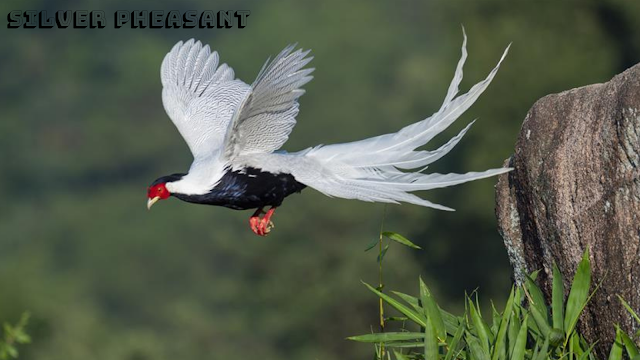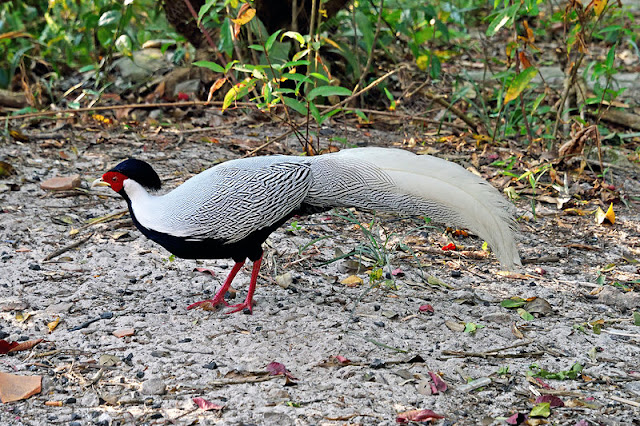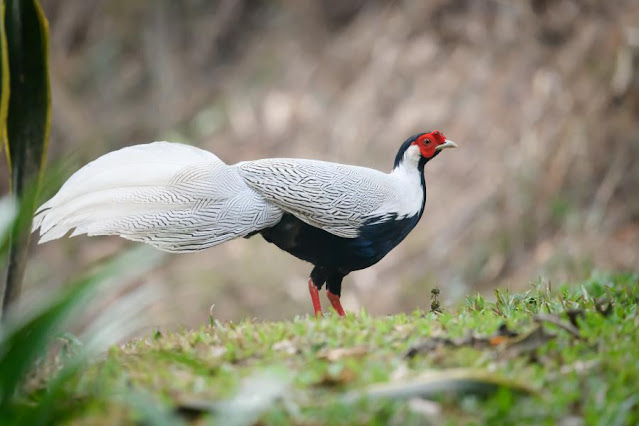The silver pheasant (Lophura nycthemera) is a species of pheasant found in forests, mainly in mountains, of mainland Southeast Asia, and eastern and southern China, with introduced populations in Hawaii and various locations in the US mainland. The male is black and white, while the female is mainly brown. Both sexes have a bare red face and red legs (the latter separating it from the greyish-legged kalij pheasant). It is common in aviculture, and overall also remains common in the wild, but some of its subspecies (notably L. n. whiteheadi from Hainan, L. n. engelbachi from southern Laos, and L. n. annamensis from southern Vietnam) are rare and threatened.
Behaviour
Silver Pheasant feeds on plant matter such as seeds and
fruits. It scratches the ground with the feet, and sometimes digs with the
bill. It also takes invertebrates according to the season. It usually feeds in
the morning and the evening, before to reach the roost. As most of grassland
pheasants, the Silver Pheasant is polygamous. The dominant male may mates with
several females. It defends the territory by giving loud whistles.
Typical courtship displays is the “wing-whirring”. The male
is on the ground and performs fast wing beats, producing vibrations and
whirring noises. This display is the most important of the courtship. It is
also used as warning between males. Female also performs wing-whirring, and in
that case, this display would be used like contact call in order to gather all
the members of the family group. During the courtship displays, the head’s
ornaments are very bright in colour, whereas outside the breeding season, they
are duller and reduced.
Diet
Silver pheasant feeds mainly on seeds and fruits, but they
also consumes invertebrates. They are fantastic natural foragers eating a diet
of berries, seeds, grains, greens, and also insects. In addition, you will also
need to give supplement to them with a standard game bird feed. Also don’t forget to always provide fresh
water daily.
Breeding
Hens can lay up to
around 20 eggs in a season which are incubated for 25 - 26 days. They start
laying at the end of March or beginning of April and will continue until around
the end of May. The biggest problem is the availability of unrelated stock in
the UK as there are very few breeders. In fact I would really like to hear from
other breeders so that we can increase our numbers in the future.
Sexing Silver Pheasant Chicks
Males have fine white lines showing firstly on the tail and
then on the wings. This should be noticeable by the time they are about three
months old. Within the next couple of months the new feathers coming through
will show much more of the detailed markings. The hen has a crest similar to
the cock but she is fairly plain with medium brown feathers although the breast
feathers are paler and almost look dusted with white chalk.
Silver Pheasant Lifespan
The average life expectancy of this species is 15 ot 20
years. In fact, the silver pheasant have low survival rate. According to a
certain source, 35% your birds die before they reach the age of 6 to 10 weeks.
Only 2 to 3% birds manage to survive to the age of 3 years in the wild.
In the wild, the
pheasant die of old age is very difficult to find. If ever, it is so rarely.
Why? Because this bird is a prey species. The main predators are foxes, hawks,
and owls which hunt the young birds. Even, from the day it is laid in the nest,
the egg must face the threat from raccoons and skunks which feed on them.
Threats
On the whole this species suffers few threats due partly to
its very large range and secondly because it prefers mountainous habitats which
are less likely to be built upon by humans. However, there are a couple of its
subspecies which are starting to decrease slowly due to habitat destruction.
Interesting facts
For a male to reach its full adult plumage takes at least 2
years.
Share with Your Friends..
Reference:
https://www.thainationalparks.com/species/silver-pheasant
https://www.beautyofbirds.com/silverpheasants.html
http://www.oiseaux-birds.com/card-silver-pheasant.html
















No comments:
Post a Comment